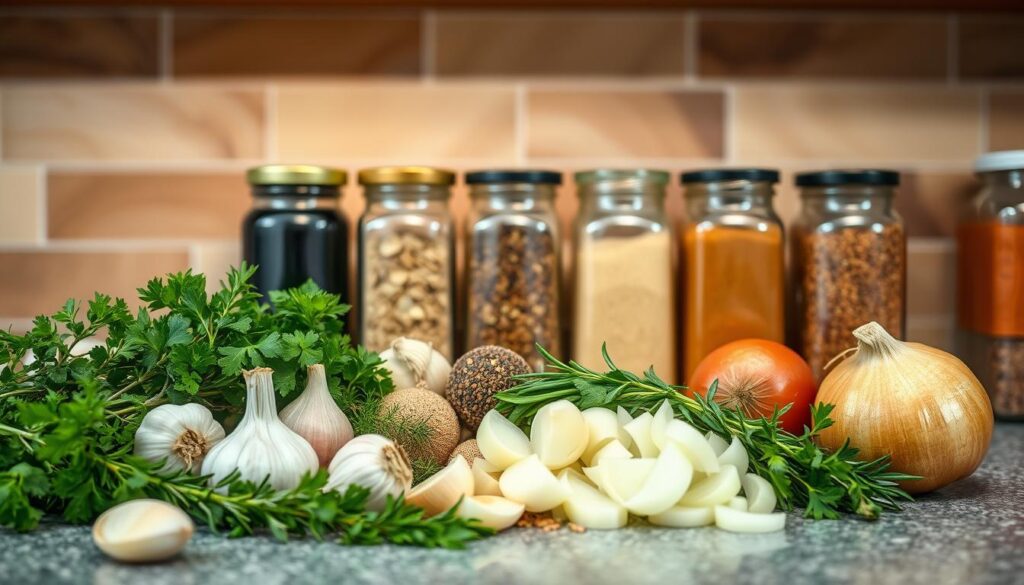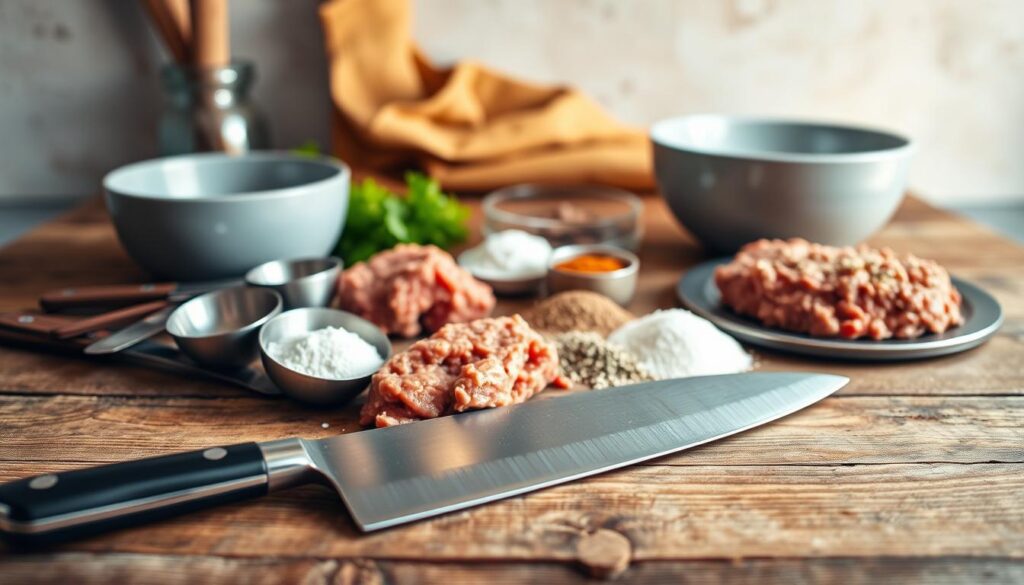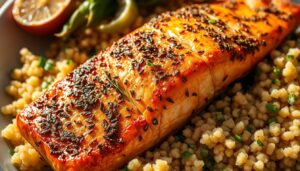Craving a delicious low sodium meatloaf that doesn’t compromise on taste? You’re in the right place. This healthy meatloaf recipe from luyarecipes.com transforms the classic comfort food into a nutritious meal that supports your heart health and dietary goals.
Reducing sodium intake doesn’t mean sacrificing flavor. Our low sodium meatloaf proves that healthy cooking can be both simple and satisfying. With carefully selected ingredients and smart seasoning techniques, you’ll create a mouthwatering dish that everyone at the table will love.
Whether you’re managing blood pressure or simply seeking a healthier meal option, this low sodium meatloaf recipe offers a perfect solution. Fresh ingredients and creative seasoning make this a standout healthy meatloaf recipe that proves nutritious food can be incredibly delicious.
Key Takeaways
- Discover a heart-healthy alternative to traditional meatloaf
- Learn how to reduce sodium without losing flavor
- Easy-to-follow recipe suitable for all skill levels
- Nutritious meal that supports overall wellness
- Versatile recipe adaptable to dietary needs
Understanding the Benefits of Low Sodium Meatloaf
Discovering low sodium dinner ideas can be a game-changer for your health. Sodium-conscious cooking isn’t just a trend—it’s a powerful approach to improving your overall wellness. A low sodium meatloaf offers multiple health advantages that can transform your meal planning and nutrition strategy.
Heart Health and Blood Pressure Management
Reducing sodium intake is crucial for maintaining a healthy heart. High sodium consumption can lead to increased blood pressure, putting extra strain on your cardiovascular system. By choosing a low sodium meatloaf, you’re taking a proactive step toward protecting your heart and managing your blood pressure more effectively.
Weight Management Benefits
Sodium can cause water retention and bloating, making weight management challenging. Low sodium dinner ideas help you control your weight by reducing unnecessary water weight and supporting a more balanced metabolism. Your body will thank you for making smarter protein choices that don’t compromise on flavor.
Overall Nutritional Value
“Eating well is a form of self-respect.” – Unknown
Sodium-conscious cooking doesn’t mean sacrificing nutrition. A well-prepared low sodium meatloaf can be packed with high-quality protein, essential nutrients, and delicious flavors. By incorporating lean meats and vegetables, you’re creating a meal that supports your body’s nutritional needs while keeping sodium levels in check.
Essential Ingredients for Low Sodium Meatloaf
Creating delicious low sodium ground beef recipes requires careful ingredient selection. Your low sodium meatloaf with oats starts with high-quality, lean ground beef as the primary protein. Choose beef with less than 5% sodium content to keep your meal heart-healthy.
“The right ingredients make all the difference in transforming a simple meatloaf into a nutritious masterpiece.”
Rolled oats serve as an exceptional binder in low sodium meatloaf recipes. They help maintain moisture while reducing overall salt content. You’ll want to use old-fashioned rolled oats for the best texture and nutritional value.
Key ingredients for your low sodium meatloaf include:
• Lean ground beef
• Rolled oats
• Egg
• Onions
• Fresh herbs (parsley, thyme)
• Salt-free seasoning blends
• Garlic powder
• Black pepper
For additional flavor without sodium, experiment with fresh herbs and spices. Dried herbs like oregano, basil, and rosemary can elevate your meatloaf’s taste profile. Remember that fresh ingredients always provide the most vibrant flavors in low sodium cooking.
Want more detailed ingredient information? Visit luyarecipes.com for comprehensive nutritional guides and expert cooking tips tailored to heart-healthy meal preparation.
Kitchen Tools and Equipment Needed
Preparing a delicious low sodium meatloaf requires more than just great ingredients. The right kitchen tools can make a significant difference in your cooking process and final result. Selecting the proper equipment ensures you can create a flavorful meal while maintaining low sodium seasoning techniques.
Your kitchen arsenal should include versatile mixing tools that help distribute low sodium meatloaf seasoning evenly. A large mixing bowl with high sides prevents ingredient spillage and allows thorough mixing. A sturdy wooden spoon or silicone spatula works best for combining ground meat with seasonings without overworking the mixture.
Essential Mixing Tools
When preparing low sodium meatloaf, precision matters. A quality digital kitchen scale helps measure ingredients accurately. Measuring cups and spoons ensure you add the right amount of low sodium meatloaf seasoning without excess salt. A meat masher or potato masher can help break up meat clumps for uniform texture.
Baking Pans and Temperature Tools
Choose a rectangular loaf pan with good heat distribution. Ceramic or glass pans work well for even cooking. A reliable meat thermometer is crucial for checking internal temperature, ensuring your meatloaf reaches a safe 160°F without overcooking.
“The right tools transform cooking from a chore to a culinary adventure.” – Professional Chef Recommendation
Invest in quality kitchen equipment to elevate your low sodium meatloaf from ordinary to extraordinary. Each tool plays a vital role in creating a delicious, health-conscious meal.
Low Sodium Meatloaf Preparation Tips
Creating a delicious low sodium turkey meatloaf doesn’t mean sacrificing flavor. Your low sodium comfort food can be packed with taste by using smart preparation techniques that elevate every bite.
Start by selecting high-quality ground turkey with a good fat content. Lean turkey can quickly become dry, so aim for meat with about 93% lean composition. Mix in grated vegetables like zucchini or carrots to boost moisture and add natural sweetness without extra sodium.
“The secret to a great low sodium meatloaf is layering flavors through herbs and spices, not salt.”
Boost your low sodium turkey meatloaf’s flavor profile with fresh herbs like thyme, rosemary, and parsley. Minced garlic and finely chopped onions provide depth without sodium. Consider using sodium-free seasoning blends or creating your own mix with dried herbs to ensure a tasty, heart-healthy meal.
Binding ingredients are crucial for maintaining your meatloaf’s structure. Use eggs, breadcrumbs, and a touch of milk to create a tender texture. Experiment with oats or almond flour as alternative binding agents for added nutrition.
Remember, successful low sodium comfort food is about creativity and understanding how to maximize flavor through smart ingredient selection and preparation techniques.
Step-by-Step Cooking Instructions
Creating the perfect low sodium meatloaf requires precision and care. This healthy meatloaf recipe will guide you through each step to ensure a delicious and nutritious meal that your entire family will enjoy.
Mixing Ingredients with Care
Start by combining your lean ground meat with carefully selected low-sodium ingredients. Gently mix the components, taking care not to overwork the meat. Overmixing can lead to a tough, dense low sodium meatloaf that lacks the tender texture you desire.
Shaping Your Meatloaf
When shaping your healthy meatloaf recipe, aim for a uniform loaf that will cook evenly. Use a shallow baking pan and create a slightly rounded top. This helps the meatloaf cook consistently and prevents dry edges.
Baking to Perfection
Preheat your oven to 350°F (175°C). Bake the low sodium meatloaf for approximately 1 hour, or until the internal temperature reaches 160°F (71°C). Use a meat thermometer to check doneness accurately.
“The key to a great meatloaf is patience and precision in cooking.” – Professional Chef’s Tip
For more detailed instructions and recipe variations, visit luyarecipes.com and explore our collection of delicious, health-conscious meal options.
Flavorful Alternatives to Salt

When crafting a delicious low sodium meatloaf, you’ll want to explore exciting flavor boosters that replace traditional salt. Sodium-conscious cooking doesn’t mean sacrificing taste. Fresh herbs, spices, and creative seasonings can transform your meatloaf into a memorable meal.
Consider using garlic powder, onion powder, and smoked paprika as your primary low sodium meatloaf seasoning. These ingredients pack a punch of flavor without adding sodium. Fresh herbs like thyme, rosemary, and parsley can elevate your dish with vibrant, aromatic notes.
“Cooking with less salt is an art of balancing and enhancing natural flavors.” – Professional Chef
Umami-rich ingredients become your secret weapon in sodium-conscious cooking. Mushroom powder, nutritional yeast, and tomato paste provide depth and complexity to your meatloaf. These ingredients naturally intensify taste without relying on salt.
Experiment with spice blends like dried oregano, black pepper, and cayenne to create a unique flavor profile. Remember that layering different seasonings helps create a rich, satisfying taste that makes you forget about sodium entirely.
Healthy Sides to Serve with Your Low Sodium Meatloaf
Creating a delicious low sodium dinner doesn’t stop with the main dish. The right side dishes can transform your meatloaf into a complete low sodium comfort food experience that satisfies both taste and nutrition.
Selecting the perfect accompaniments can elevate your meal from simple to spectacular. Vegetables provide an excellent way to add flavor and nutrition without increasing sodium content.
Vegetable Pairings that Complement Meatloaf
Roasted vegetables offer a delightful contrast to meatloaf’s rich flavor. Consider crisp roasted broccoli, tender asparagus, or caramelized Brussels sprouts. These options bring color, texture, and essential nutrients to your plate while keeping sodium levels low.
Grain and Starch Options
When exploring low sodium dinner ideas, quinoa and cauliflower rice make excellent alternatives to traditional high-sodium sides. Baked sweet potatoes or roasted herb-infused potatoes can also provide a satisfying starch component without compromising your dietary goals.
“Healthy eating is about creating balanced, flavorful meals that nourish your body.” – Nutrition Expert
For more detailed side dish recipes that perfectly complement your low sodium meatloaf, visit luyarecipes.com. Their collection of carefully crafted recipes will inspire your next healthy meal preparation.
Storage and Reheating Guidelines
Preserving your healthy meatloaf recipe requires careful attention to storage and reheating techniques. After preparing your delicious low sodium ground beef recipes, proper storage becomes crucial for maintaining both flavor and food safety.
Refrigeration is your first line of defense for keeping meatloaf fresh. Store your leftover meatloaf in an airtight container within two hours of cooking. When refrigerated properly, your meatloaf can stay fresh for 3-4 days. Always use shallow containers to help the meatloaf cool quickly and prevent bacterial growth.
“The key to great leftovers is smart storage and gentle reheating.” – Professional Chef Tip
Freezing extends the life of your healthy meatloaf recipe significantly. Wrap individual slices or the entire loaf tightly in plastic wrap, then place in a freezer-safe container. Frozen meatloaf can last up to 3 months. When you’re ready to enjoy, thaw in the refrigerator overnight for best results.
Reheating requires a gentle touch to prevent drying out. Preheat your oven to 350°F and cover the meatloaf with aluminum foil. Warm for about 20-25 minutes, or until the internal temperature reaches 165°F. A splash of broth can help maintain moisture in your low sodium ground beef recipes.
Common Mistakes to Avoid
Creating the perfect low sodium meatloaf can be tricky. Many home cooks struggle with maintaining flavor and texture while reducing salt content. Understanding potential pitfalls in sodium-conscious cooking helps you craft a delicious and healthy meal.

Solving Texture Challenges
Dry or crumbly meatloaf often results from incorrect moisture management. Your low sodium meatloaf seasoning should include ingredients that retain moisture. Consider adding grated vegetables like zucchini or carrots, which naturally increase juiciness without adding sodium.
“The secret to a moist meatloaf is balancing lean meats with moisture-rich ingredients.” – Professional Chef
Mastering Seasoning Balance
Reducing salt doesn’t mean sacrificing flavor. Experiment with herbs like thyme, rosemary, and fresh parsley to enhance your meatloaf’s taste profile. Avoid overcompensating with strong spices that might overwhelm the dish’s natural flavors.
Sodium-conscious cooking requires creativity. Replace salt with fresh herbs, citrus zest, and aromatic spices. Each ingredient should complement the meat’s natural taste without dominating the overall flavor.
Variations and Dietary Modifications
Exploring different variations of low sodium meatloaf can help you keep your meals exciting and nutritious. A low sodium turkey meatloaf offers a lean protein alternative that’s both delicious and heart-healthy. By swapping traditional ground beef for turkey, you’ll reduce sodium and fat content while maintaining fantastic flavor.
“Creativity in the kitchen means adapting recipes to fit your dietary needs without sacrificing taste!” – Culinary Nutrition Expert
For those avoiding gluten, a low sodium meatloaf with oats provides an excellent solution. Oats work perfectly as a binder, replacing breadcrumbs and adding nutritional value. This variation works especially well for individuals with celiac disease or gluten sensitivities.
You can experiment with various protein sources and mix-ins to create unique meatloaf experiences. Consider trying ground chicken, plant-based alternatives, or even adding finely chopped vegetables to boost nutrition. Each modification allows you to customize your meal while keeping sodium levels low.
Check out luyarecipes.com for more exciting low sodium meatloaf recipes that cater to different dietary preferences and taste profiles. Whether you’re looking for Italian-inspired seasonings or Mexican-style flavors, there’s a meatloaf variation waiting for you!
Conclusion
Creating a delicious low sodium meatloaf doesn’t have to be complicated. With the techniques and tips shared in this guide, you can transform your dinner routine into a heart-healthy culinary adventure. Low sodium dinner ideas like this meatloaf prove that reducing salt doesn’t mean sacrificing flavor or enjoyment.
Each recipe variation offers an opportunity to explore new taste profiles while maintaining your nutritional goals. Whether you’re managing blood pressure, watching your sodium intake, or simply seeking healthier meal options, this low sodium meatloaf recipe provides a versatile foundation for nutritious cooking.
Ready to elevate your meal planning? We invite you to explore more exciting recipes and cooking techniques at luyarecipes.com. Our collection of low sodium dinner ideas will inspire you to create delicious, health-conscious meals that your entire family will love. Start your culinary journey today and discover how simple and satisfying healthy cooking can be.
Remember, every meal is an opportunity to nourish your body and delight your taste buds. With practice and creativity, you’ll master the art of crafting flavorful, low sodium dishes that support your wellness goals.
FAQ
What makes a low sodium meatloaf different from traditional meatloaf?
A low sodium meatloaf reduces salt content while focusing on alternative flavor enhancers like herbs, spices, and aromatic vegetables. Instead of relying on salt, this version uses ingredients like garlic powder, onion powder, fresh herbs, and low-sodium seasonings to create a delicious, heart-healthy meal that supports better blood pressure management.
Can I still make a flavorful meatloaf without using salt?
Absolutely! You can create an incredibly flavorful meatloaf by using fresh herbs, aromatic vegetables, and spices like paprika, thyme, rosemary, and black pepper. Ingredients like mushrooms, tomato paste, and Worcestershire sauce can add depth and umami flavor without increasing sodium content.
Is ground turkey a good alternative for low sodium meatloaf?
Ground turkey is an excellent option for a low sodium meatloaf. It’s leaner than ground beef and provides a great protein source. To keep turkey meatloaf moist, incorporate ingredients like oats, grated vegetables, or a small amount of milk to prevent dryness while maintaining a heart-healthy profile.
How can I ensure my low sodium meatloaf stays moist?
To keep your meatloaf moist, use binding ingredients like oats or breadcrumbs, incorporate grated vegetables such as zucchini or carrots, and avoid overmixing the meat. Adding a small amount of low-sodium broth or milk can help maintain moisture, and be careful not to overcook the meatloaf.
What are some good low-sodium seasoning alternatives?
Great low-sodium seasoning alternatives include fresh herbs like basil, thyme, and parsley, spices such as garlic powder, onion powder, paprika, and black pepper. Citrus zest, balsamic vinegar, and low-sodium Worcestershire sauce can also add complex flavors without increasing sodium content.
Can I freeze low sodium meatloaf?
Yes, you can freeze low sodium meatloaf! Allow the meatloaf to cool completely, then wrap it tightly in plastic wrap and aluminum foil. It can be stored in the freezer for up to 3 months. Thaw in the refrigerator overnight and reheat gently to maintain moisture and flavor.
Are there gluten-free options for low sodium meatloaf?
Definitely! You can use gluten-free alternatives like rolled oats, almond flour, or gluten-free breadcrumbs as a binder. These options not only keep the meatloaf gluten-free but can also help reduce sodium content while maintaining a great texture.
How can I add more vegetables to my low sodium meatloaf?
Incorporate grated or finely chopped vegetables like zucchini, carrots, bell peppers, or spinach directly into the meatloaf mixture. These vegetables add moisture, nutrition, and flavor while helping to keep the sodium content low. They also contribute additional nutrients and fiber to your meal.









